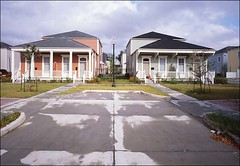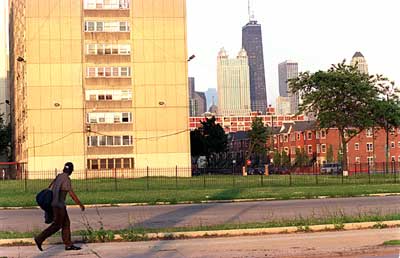Architecture Arguments Don't Help Housing
is the title of an important piece by Blair Kamin, architecture writer for the Chicago Tribune, although this piece appeared in Metropolis magazine and was subsequently reprinted in Business Week.
 River Garden, New Orleans. Fred R. Conrad/The New York Times
River Garden, New Orleans. Fred R. Conrad/The New York Times  Cabrini-Green's high-rises loom over upscale town homes as the neighborhood undergoes a radical change. (Tribune photo by Nancy Stone) Posted July 4, 2004.
Cabrini-Green's high-rises loom over upscale town homes as the neighborhood undergoes a radical change. (Tribune photo by Nancy Stone) Posted July 4, 2004. Proposed Fordham Tower designed by Santiago Calatrava, Chicago.
Proposed Fordham Tower designed by Santiago Calatrava, Chicago.Kamin writes:
In city after city across America tall towers are being proposed or built, and they are not office buildings, but places to live....
Here's my question: Now that architects are taking shots at one another over housing, can we do better than we did in the last century, which gave us sprawl for the middle class and Cabrini-Green for the poorest of the poor? Can we close the great divide between fetishistic formalism and social responsibility? Or are we doomed to a world in which architecture's leading practitioners use their work merely to comment on social tumult rather than actually trying to do something about it? ...
To Johnson, on the other hand, Modernism was simply a style, a phenomenon of art history, something that might reflect the human condition but wouldn't really deal with the condition of humans....
All this is to say that the leading avant-garde Modernists of our time, unlike their predecessors, are pretty much without a program for housing. Frank Gehry likes to call himself a "liberal do-gooder," and he does the occasional socially conscious design, but let's face it: his lefty-ness is really about progressive aesthetics, not progressive politics.
And yet a world without an intelligent debate about housing is not a world you want to live in — trust me. Here in Chicago during the mid-twentieth century, the politics of race and class, along with bureaucratic cost-cutting, produced the ultimate perversion of Weissenhof — the endless anonymous, crime-ridden high-rises of the Chicago Housing Authority, which proved of so little lasting public value that many of them have been torn down.
But as they fall, other monsters are rising, spiritless concrete slabs heaped atop hulking parking garage podiums where yuppies and empty nesters deposit their Saabs and Beemers. This is what Sam Hall Kaplan might call "plop architecture," or public housing for the rich.
Even when the podiums get tarted up with traditional decoration, they deaden the streetscape like neutron bombs. As much as I'm excited by the prospect of Calatrava's "drill bit" corkscrewing into the sky, it's just another one-off.
I'd much prefer it if someone could develop a typology that would allow lesser talents to craft downtown living quarters that are civilized if less spectacular than the Fordham Spire.
Index Keywords: housing; urban-design-placemaking



0 Comments:
Post a Comment
<< Home